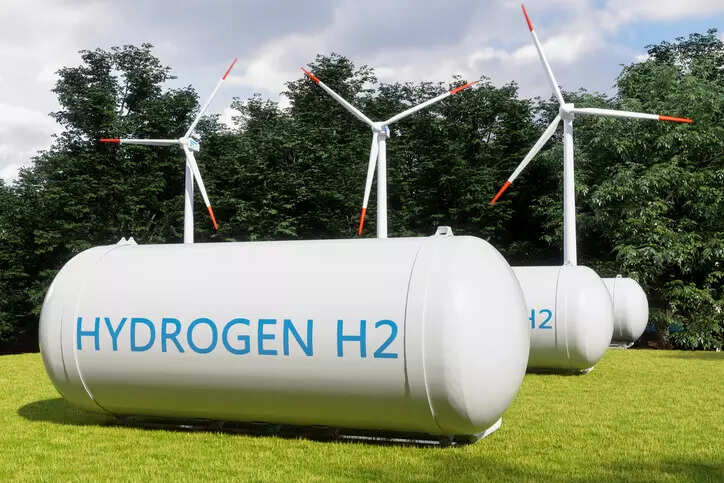
Over the last ten years, India’s economy has shown a phenomenal performance in balancing growth and inflation. As a result, India is set to double its GDP to become a USD 7 trillion economy by 2030. While the country currently ranks third in the world for energy consumption, it is expected to see the highest percentage growth in this sector over the next few years. Despite its considerable reliance on imported fossil fuels, which costs more than USD 90 billion per year, India has implemented a number of steps to decarbonize its economic growth path and meet climate targets established following the Paris Agreement. According to the Climate Change Performance Index 2023 study, India ranks in the top five countries and is the best among the G20 countries. In addition, India has pledged to achieve its net-zero emissions goal by 2070 and become energy self-sufficient by 2047.
Green Hydrogen (GH2) will be critical in achieving the aforementioned objectives. While electricity accounts for around 17% of total energy use in India, more efforts are required to reduce greenhouse gas emissions from the remaining 83%. Green Hydrogen will make a significant contribution to the clean energy transition because it is a zero emission source of energy. GH2 can be utilised in hard-to-abate sectors such as shipping, steel, aviation, and in industries that already use Grey Hydrogen derived from natural gas, such as refineries and fertilizers.
Green Hydrogen initiatives introduced in India
Several policies and guidelines have been established by India to promote green hydrogen, including the Green Hydrogen Policy, Harnessing Green Hydrogen by Niti Ayog, and the National Green Hydrogen Mission (NGHM). The NGHM aims to achieve a green hydrogen production capacity of at least 5 MMT per year, generate investments of over Rs. 8 lakh crore, and create over 6 lakh jobs. The government has taken significant steps, such as waiving inter-state transmission charges and providing GH2 plants with open access to the grid. The government has announced Rs. 19,744 crore in the latest budget for several programmes to encourage green hydrogen, including domestic manufacturing of electrolysers and GH2 production.
Green Hydrogen – Upcoming action plans
India is taking major steps towards green hydrogen usage. By June 2023, the government intends to create a framework for the distribution of incentives of roughly Rs 1,300 crore, which will be distributed through a competitive bidding process. The goal is to support 3.6 million tonnes of GH2 capacity over the next three years, with the incentive amount per kilogramme of GH2 decreasing annually. In addition, The Solar Energy Corporation of India (SECI) plans to issue a mega tender to aggregate demand for fertiliser plants and refineries. Furthermore, Kandla port on the west coast and Tuticorin port on the east coast have been designated as India’s first green hydrogen and green ammonia refuelling hubs. By the end of 2023, hydrogen fuel cell technology will be used to power 8 trains on narrow-gauge heritage routes.
Green Hydrogen – Implementation challenges
Making it economically viable
The high cost of manufacturing green hydrogen (GH2) using renewable energy is the most significant barrier to its adoption in India, accounting for around 65% of the entire cost. According to the European Commission, the cost of producing GH2 is between Rs 250-525/kg ($3-6.5/kg), while grey hydrogen costs Rs 150/kg ($1.8/kg). According to NITI Aayog, GH2 utilising Round-The-Clock (RTC) RE with Transmission & Distribution waiver is projected to cost $2.1/kg by 2030, whereas GH2 using onsite RE may be in the range of $1.8-$2.4/kg. Low-cost renewable energy plants, local electrolyser manufacturing, and technological advances in electrolysers can all help to reduce the cost of GH2.
Green Hydrogen – Is it a chicken and egg problem?
The growth of any upcoming industry requires the government to incentivize supply and create demand through policy interventions. For the GH2 industry, the measures to boost demand have not kept pace with the substantial incentives provided for supply. In October 2021, the draft National Hydrogen Energy Mission Document stated specific Green Hydrogen Consumption Obligations (GHCO) for fertilizer production and petroleum refining sectors to gradually increase to 100% by FY 34-35. The city gas networks were also planned to blend natural gas with green hydrogen at a progressive rate. The draft document predicted that the increased adoption of green hydrogen consumption would gradually reduce production costs and have a marginal impact on final product prices. This would allow for a smoother transition to green hydrogen adoption without affecting the consuming sectors. However, the published version of the NGHM document in January 2023 did not specify GHCO. Instead, it provided a general guideline for the minimum share of green hydrogen or its derivative products’ consumption by designated consumers as energy or feedstock, taking into account availability of resources, relative costs, and other economic factors. Several Indian companies are cautious about investing in green hydrogen due to uncertainty surrounding demand.
Availability of RE at a reasonable price
It is critical for the success of GH2 to ensure a steady and inexpensive supply of renewable energy (RE). Despite several policies to make renewable energy available, the reality on the ground is somewhat different. The usage of renewable energy in the grid can lead to a shift in supply and demand hours on a daily load curve. Calculating the ultimate rate for RE to be available in real-time at GH2 locations is the key challenge, and it varies by state. States also lack rules defining incentives for GH2 plants, and investors are concerned about RE supply continuity over the plant’s 20-25-year lifespan.
Production dependent on limited natural resources – Water and land
According to an EY analysis, India will need 115 GW of renewable energy power and 50 billion litres of demineralized water by 2030 to meet its 5 MMTPA GH2 objective. GH2 manufacturing is dependent on limited natural resources such as water and land. The creation of GH2 requires a lot of power and water, with each kilogramme of hydrogen requiring roughly 9 litres of demineralized water. A typical GH2 facility generating 10 tonnes per day requires an electrolyzer capacity of 5000 m3/hour, which requires renewable energy supply from a 150 MW plant, which typically requires around 750 acres of land. With a growing population and economy, the demand for water will only increase, and land and water scarcity in many parts of India will pose a significant challenge for large-scale adoption of GH2.
Overcoming challenges
● To reduce Green Hydrogen (GH2) costs, India needs consistent and low-cost renewable energy.
● India needs to invest in indigenous manufacture of Electrolysers and secure geo-political partnerships for procurement of critical minerals to overcome Electrolyser related challenges.
● Hydrogen hubs near demand centres can lower GH2 transportation costs.
● India must invest in sustainable water usage and utilize industrial/municipal wastewater or seawater for electrolysis.
● R&D is necessary to enhance Electrolysers’ efficiency, stack life, and reduce water and power requirements.
● To encourage exports, GH2 projects and RE plants may be eligible for tax and duty waivers.
Ensuring consistent availability of RE at least possible rate
To ensure the success of GH2, it is crucial to guarantee consistent availability of renewable energy (RE) at the lowest possible cost. A reduction of one rupee in RE expenses can result in a Rs 60 reduction in GH2 costs. Central and state authorities need to collaborate to establish clear pricing for RTC RE power and ensure its continuity throughout the project’s 25-year operating life. The utilization of RE in combination with grid-scale battery storage can maximize RE usage, safeguard RE and GH2 investments, and provide flexibility in power system management. To lower power costs, it may be necessary to waive or decrease banking, transmission, and distribution charges. States must release GH2 policies quickly, specifying incentives for duties and tax exemptions, subsidies, infrastructure facilities, and banking.
The way forward
Green Hydrogen (GH2) should be viewed as a complement to other alternative energy sources rather than a standalone solution. Despite the challenges of high production costs and the need for regulatory support and large-scale investment, green hydrogen is a vital element in India’s shift toward clean energy. Overcoming these barriers is crucial to sustain India’s progress towards achieving clean energy goals.
[This piece was written by Santanu Roy, Principal Advisor – Green Hydrogen, GPSR ARYA (GPS Renewables)]

